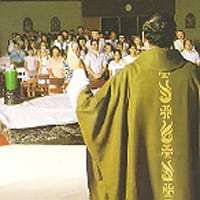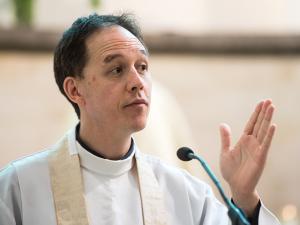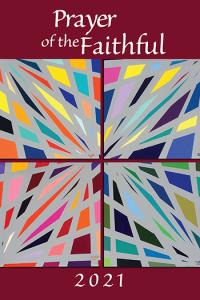………………………………………………………………………………………………

A dis– MISSA –l sends us on MISS –ion to the world. What kind of world IS that?
You can best tell what a thing really is by the way it ends: I get that idea from an old saying about life. “Count no man happy until the end is known.” Here I’m applying it to the Mass. (It’s my excuse for writing such a long post on the shortest part of the Mass.) At the end of the old Latin Mass, we finally heard the word missa, which is Latin for Mass.
I remember “Ite, missa est,” the dismissal that the priest pronounced. Our missals translated it “Go, the Mass is ended.” But that translation misses the double meaning, which I think was deliberate in the Latin text. The translation in the title is my attempt to redress that omission.
If missa = Mass, a noun, then “Ite, Missa est” means, literally, “Go, the Mass is…(complete).” But missa est is also a compound verb. It’s a form of the word for “send.” It doesn’t just tell us the Mass is over, so get going now. It sends us on a mission to the world. If this missa is also what the Mass is, then the Mass has only begun.
This is the seventh post in the series in which an imaginary extra-terrestrial visitor is helping us think about the Mass. This post looks at how the Mass, in one sense, is complete. It’s a time of plenty. It has everything it needs, especially when the lay people play their parts in the reformed liturgy. But the Mass, in the sense of mission, doesn’t end in church. It spills out into the world, So this post also asks about the world. What sort of completeness or plentifulness, if any, do we find when we go there. What does the Mass itself tell us to look for?
No more “parachuting priests”
At Mass we are in the midst of plenty. There is always enough Jesus, enough love, forgiveness, peace to go around. The people who gather for liturgy have everything they need, including Jesus’ presence in the gathering itself. Liturgy is a space and a time of plenty. Is the world similarly a place of plenty? It will help if we understand more about the plenty that characterizes the Eucharist.
Our imaginary extraterrestrial observed the old liturgy on a previous trip to earth. Then she saw something we also often saw. A second priest showed up near the end of Mass. He just dropped in, as if by parachute, to help the first priest give out Communion. It seemed like a practical measure, and nobody thought twice about it. But it never happens today, and that is worth thinking about. Today when the priest needs help distributing Communion, he gets it from members of the worshiping assembly. The liturgy has all it needs as long as it honors the gifts of all who gather.
That’s the point about the plenty that characterizes the Eucharist. The liturgy has all it needs because the body of Christ is there. That body has members, all of whom are important. Because today’s liturgy honors the gifts of the whole Body of Christ present and worshiping, it doesn’t need parachuting priests.
Liturgy needs the laity.
The new liturgy shows how important everyone is. It demands a lot, and there are roles specifically for lay people:
- Acolyte, or altar server, used to be one of the steps, “minor orders,” on the way to priestly ordination. A priest’s vocation often stemmed from a boy’s experience of serving at Mass. Today acolyte is officially a lay role. Women and girls can be altar servers. And that, Patheos blogger David Armstrong says, doesn’t hurt boys’ vocations.
- Lector, or reader, was another minor order now given to the laity. Today the lector is, perhaps, the most visible sign that the ordained one doesn’t say the whole Mass. He sits and listens while a lay person serves.
- Music ministry is no longer decoration or optional. I remember “low Masses” and “high Masses.” High Masses – more candles, singing. Low Masses – fewer candles, no singing. Today, if singing is possible, it’s expected. A cantor leadss hymns and sing psalm verses. Choirs add their particular beauty to the Mass.
- The assembly has many roles that liturgy assigns only to them. “Active participation” describes the lay people’s parts. That doesn’t mean people hadn’t been actively participating before. But I hadn’t learned then that my participation was essential to the Mass. I only knew it was essential for me.
- The Communion Procession locates the assembly’s most important role. Our space visitor thought it odd that formerly many people stayed behind and didn’t receive Communion. Some even left right after the priest gave himself Communion, and that looked really odd. She didn’t know that a Mass is complete, so they taught us, at the priest’s Communion. You could leave then and still have made your Sunday Mass obligation. As if the priest’s Communion was essential and ours wasn’t! Thankfully, we don’t teach that anymore.
Liturgy tells us to go.
Our imaginary, but very alert, space visitor as usual notices something that we don’t think about. Why, she wonders, does the priest think he has to tell people to go? I remember thinking something else was a bit odd. The priest tells us the Mass is (finally) over, and we all exclaim, “Thanks be to God.” (Hooray, we can go now.) But our space visitor and I both needed a better view.
The liturgy was telling us to go alright, but to go with a purpose. The old Latin “missa est” sent us on mission. It didn’t specify exactly what that mission was, and perhaps that’s best. The new liturgy also is appropriately vague about the nature of this mission. The new rite gives us, at the intervention of Pope Benedict XVI, these four dismissal formulas:
- Go forth, the Mass is ended.
- Go and announce the Gospel of the Lord.
- Go in peace, glorifying the Lord by your life.
- Go in peace.
I have heard a priest or a deacon trying to be helpful with a more detailed send-off like:
Go in peace to bring God’s love to the world.
It sounds nice, but underlying it is a common, but mistaken theory about mission and attitude toward the world. It seems to imply that mission is the process of bringing God’s love to a world that doesn’t have it.
Liturgy shows us how to look at the world.
The Mass has everything it needs right there in the church building. When we say “Ite, Missa est” at the dismissal, we end one task of the Mass and begin another. That’s the literal missa, the sending on mission to the world. Do we find there, in the world, all that we need?
Sometimes it seems the opposite is happening. Instead of finding what we need in the world, we find that we are drained of our own resources. Then we go back to church on Sunday to be replenished. But the liturgy in church also tells us to be aware of God’s plentiful grace in the world. More than that, it tells us how to look for that hidden grace.
I used to think Jesus was present but hiding under the signs of bread and wine in the Eucharist. These things didn’t look much like Jesus, after all. But the sign of Jesus’ presence isn’t just bread and wine but bread broken and shared and cup that is passed. Jesus is really present also in other active signs—the gathering of the people, the leadership of the presiding priest, the celebration of our stories in the Liturgy of the Word, the offering of praise to the Father, and the sacrifice of our individual egos as we offer reconciliation and peace to each other. These active signs do look a lot like Jesus at work.
Far from hiding Jesus, Catholic liturgies make Jesus plain to our sight and hearing. It’s everywhere else, in the everyday world, where Jesus hides. But Jesus is there, too; and the liturgy shows us how to look for him.
Jesus at work in the world
Jesus is at work in the sacred, active signs of the liturgy. The words that accompany these signs tell us that it’s Jesus’ work. Words like:
- The body of Christ. Amen.
- Behold the Lamb of God, who takes away the sins of the world.
- Through him (Jesus), with him, and in him…all honor and glory is yours.
- Glory and praise to you, Lord Jesus Christ.
- The grace and peace of our Lord Jesus Christ be with you.
All of these signs, with their words, are liturgy’s ways of telling us what Jesus’ work in the world is like. They tell us something that we otherwise might fail to notice—that it’s really Jesus at work:
- Working in those who welcome strangers and in the respectful meetings and greetings where one culture or one point of view welcomes another.
- Working in the storytelling that gives meaning and direction to many peoples,
- And in those who forgive and seek forgiveness.
- Working in those who break down walls of division,
- And in those who work for peace.
Jesus is at work in the liturgy and in the wider world – and in all the same ways. There’s still a big difference between these two, the sacred and secular parts of our lives. In liturgy we pay attention to Jesus at work. In the words we say, we name Jesus at work. We can’t do that in the secular world, at least not all the time. In the secular world it’s appropriate to focus on secular things. Things that are not God deserve our attention, too. We need reminders, which liturgy gives us, of God’s constant presence—but not constant reminders.
Ite, Missa est. Go out on mission.
Knowing that God is at work in the world gives our mission to the world a special flavor. It’s less like taking on the job of doing God’s work and more like joining work that is already going on. It’s less a matter of bringing God to the world and more finding God in the world.
Catholic missionaries, along with some but not all Protestants, no longer see their mission work as saving lost souls. They don’t start out with the idea that there’s something wrong with the world or with people, needing to be fixed.
That’s not to deny the reality of individual sin or the sin of the world. When we hear one of the new versions of “Ite, Missa est,” we know that the Missa, the mission, is nowhere near over. As we leave the celebration, we know we have to make the unity in the diversity around the Eucharistic table the standard for our daily lives in a world where walls of culture, race, power, status, age, sex, just plain misunderstanding, even religious differences, and more still divide us.
The work of this Mass is just beginning. It’s time to join God’s ongoing work in the world. The world is a place full of grace. Liturgy is at grace’s leading edge. When the grace of the world moves to turn us back to liturgy in thanksgiving and praise, the world becomes more grace-filled still.
Thanks be to God.
Image credit: Anna Jaques Hospital, Newburyport












